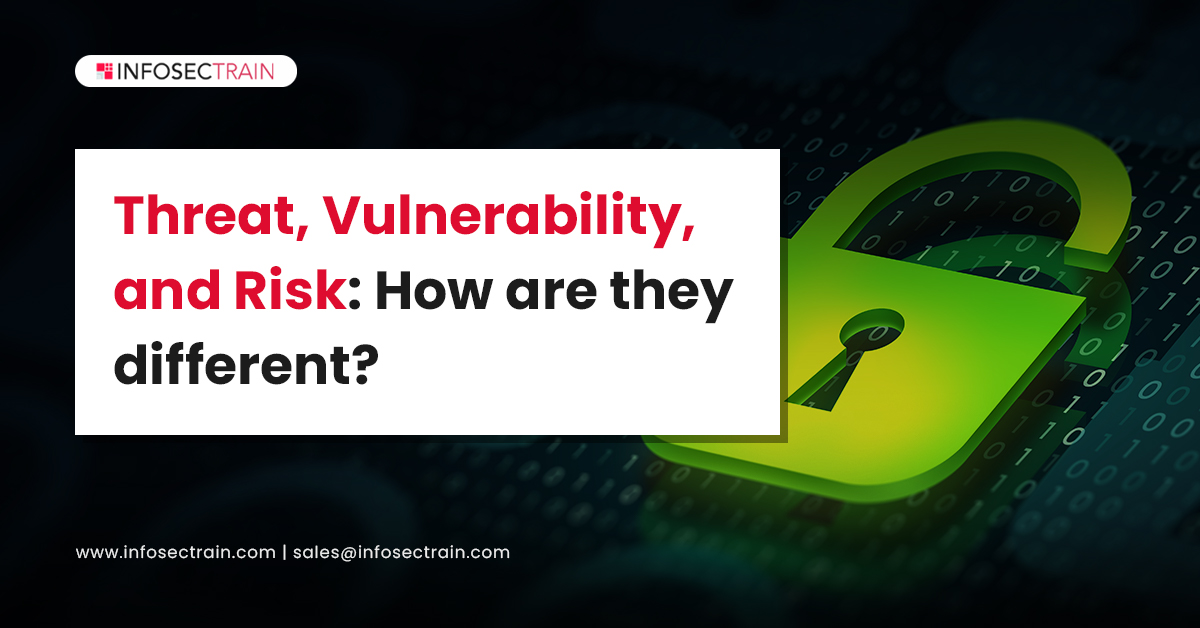Threat, Vulnerability and Risk: How are They Different?
Those who are new to cybersecurity or who have little knowledge of cybersecurity may often get confused while using some terms that may seem similar but are very different. In this blog, let us discuss those terms and how they are different. The most confusing terms in cybersecurity are Threat, Vulnerability, and Risk. These may seem the same, but they are very different from each other. Before discussing what they are and how they are different, we need to discuss something often used with these terms: Assets

Asset:
In simple terms, an asset is something you are protecting. An asset is a positive thing in practically every situation, and it often has value. Money, for example, is an asset. Assets are all items with value, like people, property, and information, which are all examples of assets.
An asset is anything that needs to be safeguarded.
It is essential to use the right words, especially in cybersecurity.
Cybersecurity, like any other sector, has its own lingo. The precision with which cybersecurity specialists utilize their language distinguishes security jargon from other forms. These terms can easily be confused and even interchanged to the untrained eye. Because there are so many moving components in cybersecurity, it’s easy for individuals new to vulnerability management to get them muddled up.
Risk, threat, and vulnerability are three of the most generally misunderstood concepts. It’s difficult to grasp how the current vulnerability management tools and technologies function if you mix these phrases up, and it’s even more challenging to communicate with other security (and non-security) experts. The distinctions are not only significant, but they are also crucial.
Risk, Threat, and Vulnerability
In a nutshell, risk refers to the possibility of losing, damaging, or destroying assets or data as a result of a cyber threat. A threat is a process that increases the possibility of a negative outcome, such as a vulnerability being exploited. On the other hand, a vulnerability is a flaw in your networks, infrastructure, or apps that could compromise your security.
Risk
The risk profile of a business change based on internal and external environmental conditions. It considers the possibility or likelihood of a negative event and the impact that event might have on your infrastructure. And while risk can never be completely eliminated, cybersecurity is, after all, a changing target, and it can be handled to a level that meets your organization’s risk tolerance. Regardless of how you approach it, the final goal is to keep your risk level minimal, manageable, and predictable.
You can manage your risk potential by creating a risk management strategy, and the steps include:
Determine needs: When it comes to establishing and executing a risk assessment strategy, prioritizing the most severe breaches to handle is vital.
Include stakeholders’ perspective: The business owners, as well as employees, consumers, and even vendors, are all stakeholders. All of these actors can have a negative impact on the organization (probable threats), yet they can also be useful in reducing risk.
Establish a central team of employees: These employees are in charge of risk management and determining the right level of funding for this task.
Apply appropriate policies and controls: These policies and controls guarantee that all modifications are communicated to the relevant end-users.
Vulnerability
Vulnerabilities are flaws in your environment and assets. Flaws that expose you to possible threats and increased risk. And sadly, a company’s vulnerabilities can be thousands or millions in number. It’s impossible to fix all of them, especially since most firms can only fix one out of every 10 vulnerabilities. While this may be a losing struggle, the good news is that only 2% to 5% of vulnerabilities are likely to be exploited. And out of those, only a tiny number are likely to constitute a real threat to your company because many of those flaws may not be actively exploited in your industry.
Threat
The cybersecurity landscape today is roiled by a never-ending stream of possible dangers, ranging from malware that embeds harmful executables in your program to ransomware that encrypts your data to specifically targeted hacking attacks. All of these dangers are looking for a way in, a weakness in your environment to exploit. On the other hand, some threats are more likely to be exploited than others. The more detailed and current information you have about these risks, the more smart and meaningful decisions you can make about vulnerability management and mitigation.
Summary
Threat, Vulnerability, and Risk are three of the most perplexing concepts in cybersecurity. To the untrained eye, these terms are confusing and even interchanged. It’s critical to utilize the proper phrases while communicating with peers and specialists, especially in cybersecurity. It’s critical to understand the difference between risk, threat, and vulnerability. If you are willing to know more about Threat, Risk, and Vulnerability, check out InfosecTrain.



 1800-843-7890 (India)
1800-843-7890 (India) 
